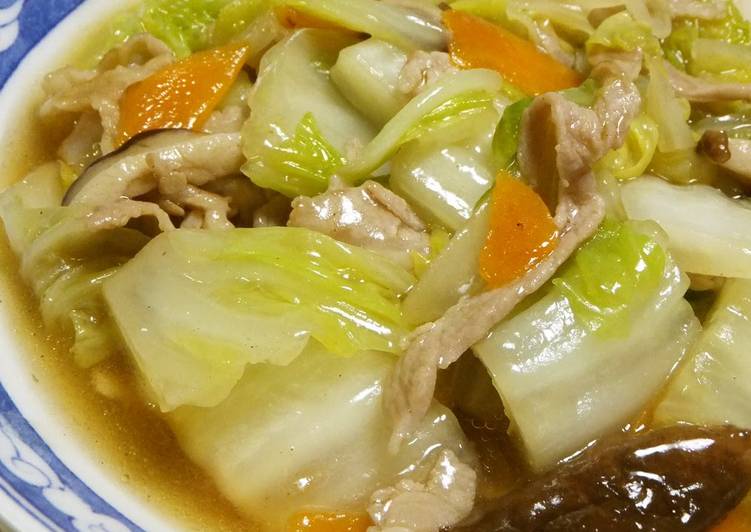Ramen Noodles with Ankake Thick Sauce. Boil the Chinese-style noodles in plenty of hot water, drain in a sieve, and transfer to a plate. Drizzle with sesame oil, and stir once. Ankake Soba is Soba noodle soup that is thickened with starch.
 Its soup is made from Rausu kelp, thick shavings of mackerel in the broth, plus pure artisan soy sauce and pork stock. Also, the noodles are homemade and made with less water so that they absorb the soup. Mix together the first six ingredients using asmall Blender Bottle [or you could use yourhand blender] while your noodles are cooking.
Its soup is made from Rausu kelp, thick shavings of mackerel in the broth, plus pure artisan soy sauce and pork stock. Also, the noodles are homemade and made with less water so that they absorb the soup. Mix together the first six ingredients using asmall Blender Bottle [or you could use yourhand blender] while your noodles are cooking.
Hey everyone, hope you're having an incredible day today. Today, I'm gonna show you how to make a distinctive dish, ramen noodles with ankake thick sauce. One of my favorites food recipes. For mine, I'm gonna make it a little bit unique. This will be really delicious.
Ramen Noodles with Ankake Thick Sauce is one of the most popular of current trending meals on earth. It is appreciated by millions every day. It's simple, it's quick, it tastes yummy. Ramen Noodles with Ankake Thick Sauce is something that I've loved my whole life. They're nice and they look wonderful.
Boil the Chinese-style noodles in plenty of hot water, drain in a sieve, and transfer to a plate. Drizzle with sesame oil, and stir once. Ankake Soba is Soba noodle soup that is thickened with starch.
To begin with this recipe, we must first prepare a few ingredients. You can cook ramen noodles with ankake thick sauce using 15 ingredients and 7 steps. Here is how you can achieve it.
The ingredients needed to make Ramen Noodles with Ankake Thick Sauce:
- {Take 1 of packet Chinese-style noodles.
- {Make ready 50 grams of Pork (offcuts, sliced belly, etc).
- {Prepare 2 of leaves Chinese cabbage.
- {Get 1/5 of Carrot.
- {Prepare 2 of Shiitake mushrooms.
- {Prepare 1 tsp of ☆Chicken stock powder.
- {Make ready 1 of heaping teaspoon ☆Oyster sauce.
- {Prepare 1 of heaping teaspoon ☆Soy sauce.
- {Prepare 300 ml of ☆Water.
- {Take 1 dash of ☆Salt and pepper.
- {Make ready 1 tsp of Sesame oil (for finishing).
- {Take 1 of for frying Oil.
- {Make ready of For the katakuriko slurry.
- {Make ready 1 tbsp of Katakuriko.
- {Get 1 tbsp of Water.
Drain the noodles and add sauce to taste. (Do not use all of this on one sleeve of noodles. This recipe makes enough for several packets of ramen noodles.) SHOYU RAMEN. Ramen noodles served in soy sauce soup, with toppings such as sliced pork, dried seaweed, bamboo shoot, green onions.. Ramen noodle in pork bone & soysauce broth with chashu (pork), bamboo, takana, kikurage, red ginger..
Steps to make Ramen Noodles with Ankake Thick Sauce:
- Chop the Chinese cabbage and carrot into bite-size pieces. Remove the stems of the shiitake mushrooms, and slice thinly..
- Heat oil in a wok, and stir-fry the pork..
- When the colour of the pork has changed, add Step 1 ingredients, and continue stir-frying until everything is coated in oil. You don't need to stir-fry well..
- Boil the Chinese-style noodles in plenty of hot water, drain in a sieve, and transfer to a plate..
- Add the ☆ ingredients to Step 3, and bring to a boil. Simmer for about 2 minutes, and thicken with dissolved katakuriko in water. Drizzle with sesame oil, and stir once..
- Pour Step 5 ankake thick sauce on top of Step 4, and it's done..
- I like sprinkling lots of pepper on top..
Yokohama-style ramen noodle with thick sauce, vegetables, bamboo, and meat. Shio (salt-based), shoyu (soy sauce-based), miso (soybean paste-flavoured), and tonkotsu (pork bone broth) are the four main types. The Udon is a thick Japanese noodle that has a very chewy and soft texture. These noodles are made with wheat flour and have a slight taste to it. The Udon noodles are seamlessly used with the soup and mild broth.
So that is going to wrap it up for this exceptional food ramen noodles with ankake thick sauce recipe. Thanks so much for your time. I'm confident you can make this at home. There's gonna be more interesting food in home recipes coming up. Don't forget to save this page on your browser, and share it to your loved ones, friends and colleague. Thank you for reading. Go on get cooking!

Posting Komentar